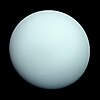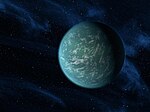astro.wikisort.org - Asteroid
Asteroid 2011 QF99 is a minor planet from the outer Solar System and the first known Uranus trojan to be discovered. It measures approximately 60 kilometers (37 miles) in diameter, assuming an albedo of 0.05.[2][4] It was first observed 29 August 2011 during a deep survey of trans-Neptunian objects conducted with the Canada–France–Hawaii Telescope, but its identification as Uranian trojan was not announced until 2013.[2][5]
| Discovery | |
|---|---|
| Discovery site | Mauna Kea Obs. |
| Discovery date | 29 August 2011[1] (first observation only) |
| Designations | |
MPC designation | 2011 QF99 |
Minor planet category | Uranus trojan[2] centaur[1] · distant[3] |
| Orbital characteristics[1] | |
| Epoch 4 September 2017 (JD 2458000.5) | |
| Uncertainty parameter 3 | |
| Observation arc | 3.97 yr (1,449 days) |
| Aphelion | 22.422 AU |
| Perihelion | 15.659 AU |
Semi-major axis | 19.040 AU |
| Eccentricity | 0.1776 |
Orbital period (sidereal) | 83.08 yr (30,346 days) |
Mean anomaly | 283.84° |
Mean motion | 0° 0m 42.84s / day |
| Inclination | 10.833° |
Longitude of ascending node | 222.52° |
Argument of perihelion | 288.25° |
| Physical characteristics | |
Mean diameter | 60 km (calculated)[2] |
Geometric albedo | 0.05 (assumed)[2] |
Absolute magnitude (H) | 9.6 (R-band)[2] 9.7[1] |
2011 QF99 temporarily orbits near Uranus's L4 Lagrangian point (leading Uranus). It will continue to librate around L4 for at least 70,000 years and will remain a Uranus co-orbital for up to three million years. 2011 QF99 is thus a temporary Uranus trojan—a centaur captured some time ago.[2][6]
Uranus trojans are generally expected to be unstable and none of them are thought to be of primordial origin. A simulation led to the conclusion that at any given time, 0.4% of the centaurs in the scattered population within 34 AU would be Uranus co-orbitals, of which 64% (0.256% of all centaurs) would be in horseshoe orbits, 10% (0.04%) would be quasi-satellites, and 26% (0.104%) would be trojans (evenly split between the L4 and L5 groups).[2] A second Uranian Trojan, 2014 YX49, was announced in 2017.[7]

2011 QF99 · Uranus · Sun
References
- "JPL Small-Body Database Browser: (2011 QF99)" (2012-10-21 last obs.). Jet Propulsion Laboratory. Retrieved 12 October 2017.
- Alexandersen, M.; Gladman, B.; Greenstreet, S.; Kavelaars, J. J.; Petit, J. -M.; Gwyn, S. (2013). "A Uranian Trojan and the Frequency of Temporary Giant-Planet Co-Orbitals". Science. 341 (6149): 994–997. arXiv:1303.5774. Bibcode:2013Sci...341..994A. doi:10.1126/science.1238072. PMID 23990557. S2CID 39044607.
- "2011 QF99". Minor Planet Center. Retrieved 12 October 2017.
- Choi, C. Q. (29 August 2013). "First 'Trojan' Asteroid Companion of Uranus Found". Space.com web site. TechMediaNetwork. Retrieved 3 September 2013.
- Alexandersen, M.; Kavelaars, J.; Petit, J.; Gladman, B. (18 March 2013). "MPEC 2013-F19: 2011 QF99". IAU. Retrieved 3 September 2013.
{{cite journal}}: Cite journal requires|journal=(help) - de la Fuente Marcos, Carlos; de la Fuente Marcos, Raúl (22 May 2014). "Comparative orbital evolution of transient Uranian co-orbitals: exploring the role of ephemeral multibody mean motion resonances". Monthly Notices of the Royal Astronomical Society. 441 (3): 2280–2295. arXiv:1404.2898. Bibcode:2014MNRAS.441.2280D. doi:10.1093/mnras/stu733.
- de la Fuente Marcos, Carlos; de la Fuente Marcos, Raúl (15 May 2017). "Asteroid 2014 YX49: a large transient Trojan of Uranus". Monthly Notices of the Royal Astronomical Society. 467 (2): 1561–1568. arXiv:1701.05541. Bibcode:2017MNRAS.467.1561D. doi:10.1093/mnras/stx197.
External links
- 2011 QF99 at the JPL Small-Body Database
На других языках
[de] 2011 QF99
Vorlage:Infobox Asteroid/Wartung/SSD_ID keine Zahl- [en] 2011 QF99
[ru] 2011 QF99
2011 QF99— первый открытый троянский астероид Урана, движущийся в точке Лагранжа L4, в 60° впереди планеты. Относится к группе кентавров. Астероид был открыт в 2011 году командой Майка Александерсена (Mike Alexandersen) из Университета Британской Колумбии при помощи Канадско-Франко-Гавайского телескопа.Другой контент может иметь иную лицензию. Перед использованием материалов сайта WikiSort.org внимательно изучите правила лицензирования конкретных элементов наполнения сайта.
WikiSort.org - проект по пересортировке и дополнению контента Википедии



